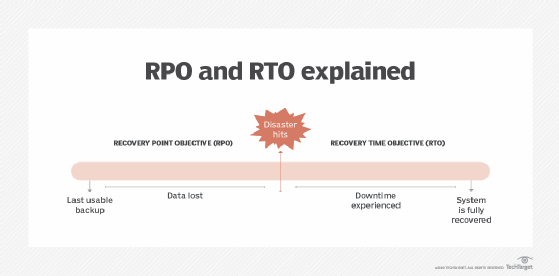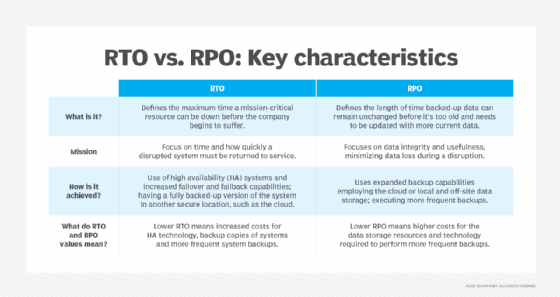RPO vs. RTO: Key differences explained with examples
As key elements of a backup and DR plan, the recovery point objective and recovery time objective help an organization decide how much data it can lose and how long it can be down.
Recovery time objective and recovery point objective are two essential metrics for developing data backup and recovery, business continuity and disaster recovery, and operational resilience plans. RTO focuses on the maximum acceptable downtime for a system or business process, while RPO designates the maximum amount of data that can be lost during an outage. Both metrics are expressed in seconds, minutes, hours or days.
This article examines both RPO and RTO, how to compute them, the cost and risk implications of these metrics, and how to build them into various business continuity/disaster recovery (BCDR) and resilience plans.
What is RTO?
A recovery time objective (RTO) specifies the amount of time from the occurrence of a disruptive event to when the affected resource must be fully, or at least nominally, operational and ready to support the organization's objectives.
An inverse relationship exists between the RTO and the cost required to support that recovery. Specifically, the shorter an RTO is in terms of time, the more recovery costs increase, and vice versa. As such, it's necessary to involve business unit leaders when determining RTO values.
How to define RTO
In BCDR planning, a business impact analysis (BIA) identifies mission-critical business processes and their supporting systems and examines how long they can be unavailable before significantly affecting an organization's ability to operate. Calculating an RTO -- sometimes known as the maximum tolerable period of disruption -- means finding out how long it takes to recover and restore each system, usually from the IT department.
For some businesses, such as those in finance and manufacturing, downtime might need to be very minimal -- e.g., less than one minute. Other systems and processes might not be as critical, and their RTOs will be higher. It's essential that business unit leaders agree with recovery time objective values because the costs involved could be significant. For example, there could be a greater need for high-availability systems and network resources with rapid failover and failback capabilities.

What is RPO?
The recovery point objective (RPO) is especially important in data backup and recovery activities. A low RPO value means data must be as up-to-the-moment as possible when it is once again used following a disruption.
Due to the inverse relationship between the RPO value and the cost to achieve it, an RPO of 10 seconds to 30 seconds, for example, means organizations must back up data frequently. To achieve that RPO, organizations might need high-speed backup technologies, such as data mirroring or continuous replication. Extensive data backup capabilities might also be needed, possibly using cloud backup resources and/or additional data storage arrays in multiple company locations, such as an alternate data center.
How do you calculate RPO?
When determining RPO values during a BIA, user departments must state how long backed-up data can remain unchanged in data storage before it's needed. The amount of time that transpires from when data is backed up to when it is needed following a disruption is the RPO. Shorter RPO values, such as those less than one minute, mean backed-up data will be needed almost immediately following a disruptive event. Backup schedules must also be examined to determine how frequently specific data, databases and systems will be backed up.
RPO vs. RTO: Similarities and differences
RTO and RPO are important metrics in BCDR and resilience planning. They are similar in that they define limits on how long a system can be unavailable and how long data can age before it might not be usable. They differ in that each metric focuses on a different business requirement -- system availability versus data usability -- that affects how long it might take for the organization to resume normal operations. The following chart details these similarities and differences.

RPO and RTO example scenarios
RTOs and RPOs are key backup and recovery metrics that ensure critical data and systems are available when needed. The table below provides examples of how missed RTOs and RPOs could affect an organization in a post-disaster scenario.
| How missed RTOs and RPOs can affect an organization | |||||
| Situation | Planned RPO | Actual RPO | Planned RTO | Actual RTO | Analysis |
| Mission-critical application | 0.5 hr | 1.5 hrs | 0.5 hr | 2.0 hrs | Application backup resources were insufficient; technology couldn't be recovered quickly enough. |
| Critical database | 0.25 hr | 2.0 hrs | 0.25 hr | 2.0 hrs | Application backup resources were insufficient; technology couldn't be recovered quickly enough. |
| Critical network switch | NA | NA | 0.5 hr | 2.0 hrs | Technology couldn't be recovered quickly enough. |
| HVAC system and associated application | 0.25 hr | 2.0 hrs | 0.25 hr | 2.5 hrs | HVAC system backup resources were insufficient; HVAC system couldn't be recovered quickly enough. |
While RPO and RTO values were aggressive for each asset listed above, the outcomes showed that the assets weren't as well protected as anticipated. The amount of time needed for recovery indicates the need for the following:
- Reconfiguration of data storage resources and backup platforms for application priorities.
- Reconfiguration and/or redesign of network infrastructure resources to reduce latency and improve the speed of recovery.
- Spare parts that can be used as part of the recovery process.
- Greater focus on critical infrastructure, environmental systems and efforts to maintain business operations.
Comparing RPO and RTO strategies
When comparing RPO and RTO, the timetables can be different. RPOs are assigned before an event occurs, while RTOs are designated after an event occurs. In practice, a short RTO usually necessitates an equally short RPO, particularly when data protection and system recovery are required.
If the disaster recovery strategy addresses only system backup and recovery, an RTO value might be sufficient to determine how recovery will take place. But if the system to be recovered also processes critical and time-sensitive data, then both RTO and RPO should be synchronized.
While IT can determine what resources are needed to achieve RTO and RPO values, they can't arbitrarily assign RTO and RPO values -- that's up to the business unit and management. Each metric helps BCDR and IT teams identify the resources and associated costs needed to achieve the desired values. If the costs to achieve the desired RTO/RPO values are prohibitively high, business units and senior management might need to decide if the investments will adequately mitigate the risks of business loss or if an alternate arrangement will be needed. Conversely, the company might decide to invest capital and operating funds to deploy resources needed to achieve RTO and RPO goals.
Best practices for optimizing RPO and RTO
The following are some best practices for optimizing RPO and RTO:
- Use event data from the risk analysis and BIA to determine the frequency and likelihood of a possible occurrence, the effects on the organization and which mitigation strategies have the highest likelihood of success. The analysis might also identify potential threats and vulnerabilities.
- IT administrators should locate infrastructure assets and identify measures that can help reduce threats or mitigate their severity, should they occur.
- Test various backup and recovery arrangements to determine a cost-effective way to deliver the desired RTO and RPO results.
RTO and RPO in cloud applications and storage
As IT operations continue to migrate to cloud environments, RTO and RPO values are just as important, if not more so, because cloud vendors have greater control over the resources needed to achieve desired RTO and RPO values. In situations such as cloud-based data storage and retrieval, users must communicate their desired RTO and RPO values to the vendor and then see how they respond.
Cloud service-level agreements should include RTO and RPO values if they are critical metrics. Since cloud vendors can scale resources to fit client needs, RTOs and RPOs might not be difficult to achieve. The challenge is to minimize the added cost to achieve new or revised RTO and RPO values.
Computing RPO and RTO
During a BIA, business unit leaders and senior management must assign numeric values to what they feel are the best-case scenarios for recovering from business disruptions.
RTO and RPO values are strictly numeric time values. For example, an RTO for a critical server might be one hour, while the RPO for less-than-critical data transaction files might be 24 hours.
As RTO and RPO values decrease, the costs to achieve those metrics are likely to increase. The only way to determine the true cost is to first identify the desired RTO and RPO values, then conduct research to determine what's needed to achieve the metric if a disruption occurs. As noted above, it might be necessary to test various solutions to determine which delivers the best outcome.
Potential resistance from management might occur if they don't want to invest additional funds to achieve the metrics given. Management must understand that additional risk and loss might result if a disruptive event occurs.
Building RTO and RPO into data backup and recovery plans
The inclusion of RTO and RPO metrics in data backup, data recovery and other resilience-based plans is essential and ensures the procedures, personnel and technology resources used to achieve the metrics are appropriate. The metrics indicate where the recovery bar has been set.
For data backup and recovery, RTO and RPO values are essential for planning, as they help determine the optimum data backup and technology configuration to achieve the goals. They're also important from a compliance and data backup audit perspective, for example, as auditors might look for evidence of these values as key data backup and recovery controls.
Editor's note: This article was updated in August 2025 to include additional information and to improve the reader experience.
Paul Kirvan is an independent consultant, IT auditor, technical writer, editor and educator. He has more than 35 years of experience in business continuity, disaster recovery, security, business resilience, networking, enterprise risk management and IT auditing.







